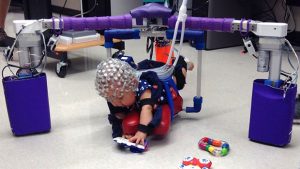Having a baby who is diagnosed with cerebral palsy is no longer the unwelcoming event it used to be. Only twenty or so years ago, babies with cerebral palsy had very few options for therapy. Not only was their life expectancy low, but their anticipated quality of life was fairly bleak, since so few doctors had an in-depth understanding of how the developing brain is affected by cerebral palsy over the span of a person’s life.
However, the past several years have brought amazing advancements in brain science. With those advancements have come major improvements in therapy for cerebral palsy babies. Along with developments in physical and occupational therapy, the past decade has brought some truly amazing technology into play that can help babies with cerebral palsy make those crucial early life advancements that create a strong foundation for their lifelong growth.
Robotic Onesie to Help Babies at Risk for Cerebral Palsy
One of the most astonishing forms of therapy is the use of robotics to strengthen and direct a baby’s earliest movements. The University of Oklahoma has brought together a team of biomedical engineers and physical therapists to create a cutting-edge device that helps babies with cerebral palsy symptoms develop motor skills.

The device involves a wheeled platform under the baby, a motorized unit that gently propels the baby forward as they move in a given direction, and a cap made of brain sensors laid over the baby’s head that sends measurements from the baby’s brain to a computer. Along with mapping out the baby’s movements on the monitor, the computer feeds the sensor data into an algorithm that can interpret what the baby is attempting to do and give them an assist in the right direction, encouraging them to keep trying.
This encouragement is crucial to the physical and neurological development of babies with cerebral palsy. According to researchers, crawling is one of the most crucial components of a baby’s early life. When a baby is between 2 and 8 months old, their brains are just starting to fire the signals for major motor movements; this is the time when babies begin to kick, pull themselves forward and crawl.
Because cerebral palsy affects babies’ motor control and muscle coordination, their earliest attempts at crawling are met with defeat and frustration. In this situation, not only are babies with cerebral palsy not able to complete their desired motion, but their brains are signaled to stop developing in that direction.
According to Thuli Kobe, the physical therapist who spearheaded the project in 2003, “Infant learning is integral, and when infants stop trying, parts of the brain responsible for the skill are negatively affected.”
Project leader Andrew Fagg added,
“Because infants with CP are unable to reliably perform the individual movements that make up crawling behavior, they learn to stop trying instead of continuing to practice these movements. In turn, cognitive development and other areas of development are delayed because they both rely on the infants being able to explore their surrounding world.”
But with the help of the robotic “onesie,” as the device is nicknamed, babies with cerebral palsy symptoms are able to strengthen both their brains and their muscles during this crucial window of time. This is particularly helpful since most cases of cerebral palsy are not definitively diagnosed until the baby is between 1 and 3 years old. Thanks to the robotic onesie, babies do not have to wait for a definite diagnosis before beginning the therapy that will help them thrive. Instead, they can begin to gain motor function no matter what their final diagnosis ends up being.
Brain Scans May Reveal Measurable Improvement
In addition, the onesie collects an enormous amount of data from the babies’ brain scans—not surprising, since babies’ brains grow at an extraordinarily rapid rate. Each session with the robotic onesie produces about 10 gigabytes of data from any given baby’s brain, and that data requires weeks of work by the research team to interpret it all. The long-term hope is to use that data to detect whether using the device leads to a measurable improvement in babies’ brain activity over time.
That goal, however, is still at least nine months distant. For now, the babies with cerebral palsy continue to practice the essential skill of crawling with the help of the robotic onesie, while the babies’ parents enjoy the daily encouragement of seeing their children develop strength, coordination and skill that provide the foundation of other capabilities they will need later in life.



